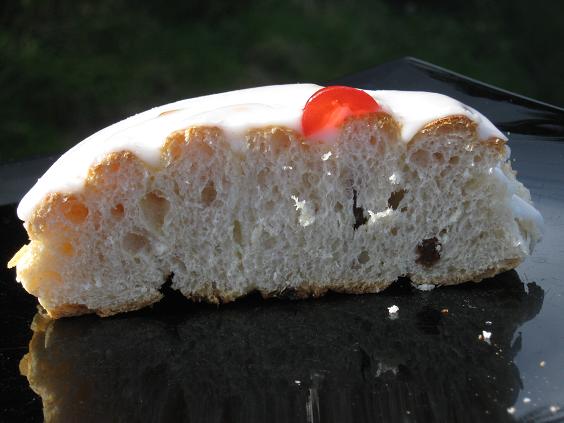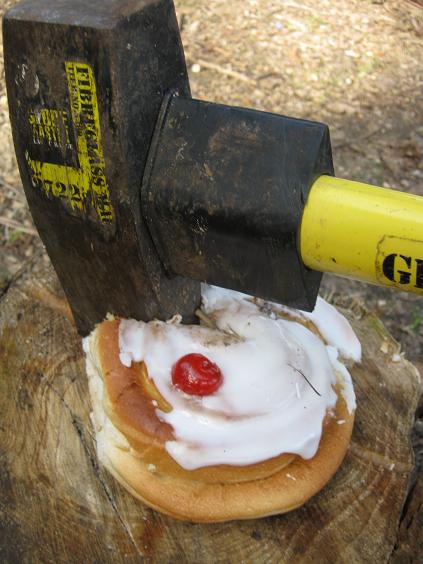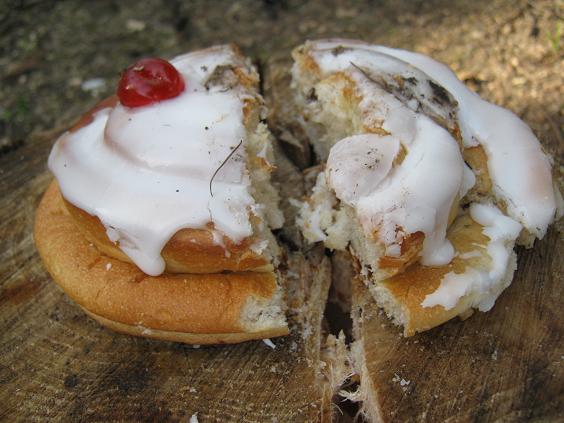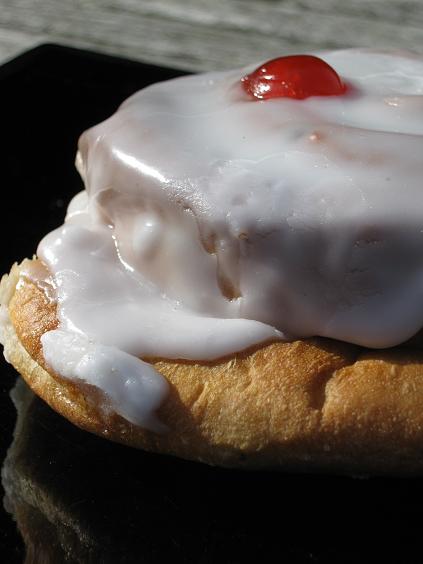

 The buns were packed with care, individually into paper bags, and then once safely packed, they were all bundled into a carrier bag like a sack of potatoes.
Fortunately they were protected by their greatest fault - they are tough enough to resist damage.
The buns were packed with care, individually into paper bags, and then once safely packed, they were all bundled into a carrier bag like a sack of potatoes.
Fortunately they were protected by their greatest fault - they are tough enough to resist damage.
 All four buns survived the indignity without damage. They had a rather bland appearance, there was some variability in shape but it failed to impart
character to the buns and seemed more like erratic mechanical activity. The buns were dry and hard, there was little pleasure in eating them.
The sultanas were sparsely distributed within the bun - detailed analysis uncovered 17 of them. There did not seem to be any lemon curd
between the coils leaving the interior rather dull, dry and uninviting.
All four buns survived the indignity without damage. They had a rather bland appearance, there was some variability in shape but it failed to impart
character to the buns and seemed more like erratic mechanical activity. The buns were dry and hard, there was little pleasure in eating them.
The sultanas were sparsely distributed within the bun - detailed analysis uncovered 17 of them. There did not seem to be any lemon curd
between the coils leaving the interior rather dull, dry and uninviting.
 When bisected, the bun had one attractive quality. Because of the diligent coiling of the structure, the surface of the bun had an attractive spiral
pattern and the icing had slumped satisfactorily into the interstices. The icing was dry in the surface, but moist enough to resist fracture. It
was a significant technical achievement and deserves some credit, though it wasn't enough to increase the appeal the bun. A good red cherry
made a brave try, but there was nothing here that was inspirational.
When bisected, the bun had one attractive quality. Because of the diligent coiling of the structure, the surface of the bun had an attractive spiral
pattern and the icing had slumped satisfactorily into the interstices. The icing was dry in the surface, but moist enough to resist fracture. It
was a significant technical achievement and deserves some credit, though it wasn't enough to increase the appeal the bun. A good red cherry
made a brave try, but there was nothing here that was inspirational.
 I was fortunate to be able to call on the services of a lumberjack to perform the test. Using the standard equipment
the bun was subjected to divisive impact using a maul - a weighted axe.
I was fortunate to be able to call on the services of a lumberjack to perform the test. Using the standard equipment
the bun was subjected to divisive impact using a maul - a weighted axe.
 The first blow was a little off centre, and disabled the bun without disecting it. The second blow made a perfect split in the structure. It required a third blow
to divide the two halves of the bun.
The first blow was a little off centre, and disabled the bun without disecting it. The second blow made a perfect split in the structure. It required a third blow
to divide the two halves of the bun.
 The mechanical strength of the bun was quite remarkable. It had been cleaved in two with an axe, yet the bun remained more or less perfect. It was a bit muddy,
but I have seen buns cut with a sharp knife that suffered greater damage. Sadly, the destruction of this bun produced more entertainment
than its consumption.
The mechanical strength of the bun was quite remarkable. It had been cleaved in two with an axe, yet the bun remained more or less perfect. It was a bit muddy,
but I have seen buns cut with a sharp knife that suffered greater damage. Sadly, the destruction of this bun produced more entertainment
than its consumption.
